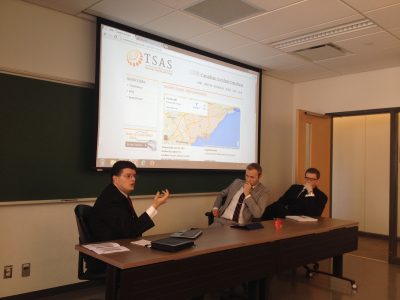Since 1960, there have been more than 1,800 incidents of terrorism and violent extremism in Canada or elsewhere that have a Canadian connection.
Now, there is a new video, developed by Carleton graduate student Matthew Howland, that showcases how prominent these incidents have been.
Howland says the video began as a project in Dr. Joshua Kilberg’s Terrorism and International Security class in the Norman Paterson School of International Affairs. The class is part of Howland’s master’s degree program in Infrastructure Protection and International Security (MIPIS).
Kilberg was in charge of developing the codebook and overseeing researchers doing the coding for the Canadian Incident Database. CIDB is a publicly accessible database that describes terrorism and violent extremism (since 1960), including incidents occurring overseas involving Canadian perpetrators, targets and victims. Five university partners are involved including Carleton.
During a conversation after a class, when Kilberg shared with Howland that he was involved in the CIDB project, Howland told him that he had experience in large data-sets and bioinformatics.
Says Howland: “As a genomicist, I was used to handling large datasets, on the order of hundreds of thousands to millions of data points, and extracting relevant narratives and creating visualizations.”
Kilberg suggested to Howland that he use the CIDB data in the best way he saw fit. Howland then created a dynamic visualization tool as well as correlate the various data parameters for data exploration. The result was the following video.
The video was unveiled in May at a launch event for the new database.
“There were literally gasps in the audience when he showed it off,” says Kilberg. “It’s really impressive stuff.”

Terrorism researcher James O. Ellis, Joshua Kilberg and Matthew Howland at the launch event. Photo courtesy: Stewart Bell, National Post
Howland says that he thinks the key point to take away from the video is that terrorism in Canada has not been confined to one location, time-period, or ideology. “It was important to convey through visual means that terrorism in Canada is not static, and I think this is shown quite well by plotting the incidents in Canada over time. I thought it was also important to show the ideologies of events over time, as no single group or ideology holds a monopoly on the use of terrorism in Canada.”
It is this kind of project that inspired Howland to sign up for the MIPIS program. He had a background in safety and security applications of radiobiology and genomics but lacked the policy background to understand how best to integrate security science into a cohesive policy framework.
“It seemed like a great program, combining both security science and also the policy background I needed, and also providing things such as a coop option,” says Howland. “I think that experience in both fields offers a unique perspective and approach to security challenges.”
You can read more about the launch of the Canadian Incident Database in the National Post.
For more information about the MIPIS program, you can visit their website. You can also watch this video of two MIPIS students.
Friday, June 5, 2015 in Grad Student Research, News
Share: Twitter, Facebook





